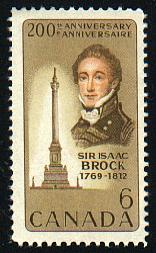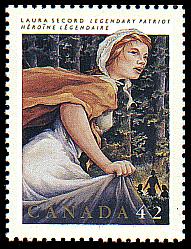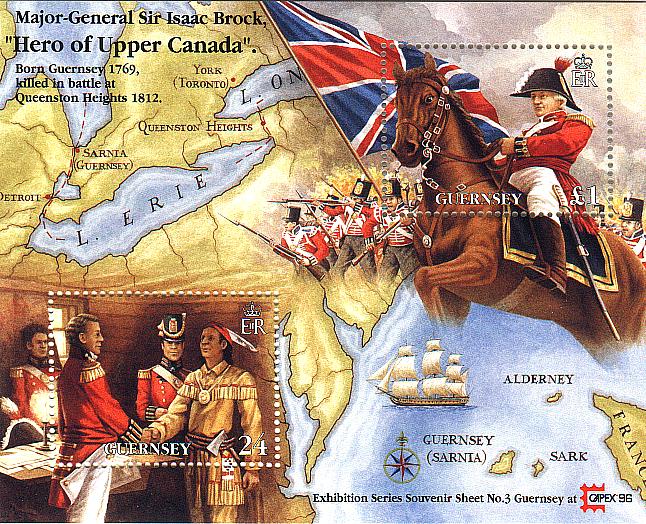Canada
and the War of 1812
by Tony Brown
Introduction
Considering
its historical significance to Canada it is surprising that so
few stamps have been issued to commemorate the War of 1812. A
by-product of the Napoleonic Wars that preoccupied most of Europe
at the beginning of the 19th century, the War of 1812, declared
by the United States on Great Britain under President James
Madison on 18 June 1812, is a source of pride to Canadians as
many inhabitants, principally of Upper Canada, fought alongside
the Regular British Army and Indian allies to thwart American
plans to capture what were then the British colonies on
their northern flank.
The
war was primarily caused by the British Navy's boarding of
American ships to forcibly enlist any sailors of British origin
and its attempts to prevent the United States from trading with
France. In addition, the Americans, who were encountering strong
resistance from Indians in their push westward, believed that
Great Britain was encouraging Indian opposition.
The
United States planned to take over Upper Canada (the basis of
modern-day Ontario) and Lower Canada (the basis of modern-day
Québec) in a single mass attack. The invasion was to occur at
four strategic locations: across from Detroit, in the Niagara
area, at Kingston, and south of Montréal. If they succeeded,
they would isolate and then capture the stronghold of Québec
City, thereby cutting off any further British troop movement up
the St Lawrence River and into the Great Lakes.
There
were wins and losses on both sides during the two years that the
war lasted, with no clear victory for either of the warring
parties (the Treaty of Ghent signed on 24 December 1814
maintained the status quo). The British colonies, however,
remained independent of the United States and their inhabitants
would continue to forge what would become some fifty years later
the new Canadian nation.
Only
three Canadian stamps featuring themes related to the War of 1812
have been issued: one commemorating the birth of Sir Isaac Brock,
"the Hero of Upper Canada," one commemorating Laura
Secord, and one in honour of Lieutenant-Colonel Charles-Michel de
Saleberry. Tecumseh, who was an important ally, has never been
portrayed on a Canadian stamp. He has, however, been honoured by
Guernsey in a 1996 souvenir sheet that was produced for CAPEX 96.
Isaac
Brock

|
Sir Isaac Brock was
the commander of the British forces at the time of the
American invasion. Born in 1769 to a military
family in Guernsey (an island in the English Channel,
then known as Sarnia), he joined the army at the age of
16. He was sent to Canada with the 49th Regiment in 1802
where he rose in rank to become in 1811 a major-general
and Commander-in-Chief of the forces of Upper Canada. In
truth, he was not entirely happy with his assignment and
would have preferred the battlefields of Europe.
Nevertheless, he planned the territory's defence
brilliantly and became a legendary hero when he was
felled by a sharpshooter at the Battle of Queenston
Heights on 13 October 1812. |
The stamp, which was issued
in 1969, commemorates the 200th anniversary of the birth of Isaac
Brock. In addition to his portrait, the stamp features Brock's
Monument, which marks his grave and is located near Queenston,
Ontario. The statue of Major-General Brock stands atop a 56-metre
column overlooking the territory that his troops successfully
defended. The monument was completed in 1856.
Laura
Secord
| Laura Secord, nee
Ingersoll, was born in Massachusetts. She moved to
Queenston, which is situated at the mouth of the Niagara
River, with her family following the US War of
Independence and then married James Secord, a Queenston
merchant and volunteer "citizen soldier." James
was seriously wounded in the battle of Queenston Heights
and was still disabled a year later in 1813 when American
forces occupied his farmhouse. Overhearing the soldiers'
careless chatter about their mission to occupy the
village of Beaver Dam, Laura slipped away to warn the
British who were in that location. It was one of the
compelling stories of the war; how she lost her shoes and
walked in darkness, barefoot, through the woods, finally
running into a British patrol under a Lieutenant
Fitzgibbon to warn them of the American plans. In the
meantime, Indians had learned of the American movements
also and ambushed them on their way to Beaver Dam. A
small band of Canadian militia also fired upon the rear
of the American force. Fearing total annihilation, the
American force, which comprised some 570 men,
immediately surrendered to Lieutenant Fitzgibbon when he
arrived on the scene. |

|
The stamp is one of a 1992 se-tenant
issue commemorating four legendary heroes. It depicts Laura
courageously travelling through the woods to warn the British of
an impending American attack on their position. The figures of
Indians, who were preparing to ambush the Americans and whom she
met along the way, are visible in the background.
Lieutenant-Colonel
Charles-Michel de Salaberry
| Charles de
Salaberry (1778-1829) was commanding officer of the
Provincial Corps of Light Infantry in Lower Canada
(Canadian Voltigeurs), 60th Regiment of Foot. He received
the rare Field Officers Gold Medal for his exceptional
service in turning back a superior force of American
regulars at the Battle of Châteauguay on 26 October
1813, thus saving Montréal from attack. This stamp is from a se-tenant pair
issued in 1979.
|

|
Tecumseh
Tecumseh was a charismatic Shawnee
native leader who was brought up with a hatred of Americans,
known as "Long Knives" to the Indians, following the
death of his father in a bloody clash with Virginian militia.
Concerned about the American westward expansion and encroachment
onto Indian territory, Tecumseh supported the British in the War
of 1812 in the hope that a British victory would assure the
Indians of possession of their lands. Indian support to the
British side of the war was a key factor in many of the British
successes.
Although no Canadian stamp
has been issued commemorating Tecumseh, he has been honoured by
Guernsey in a souvenir sheet that was produced for CAPEX
'96.

This sheet features a map
showing Lake Erie, the cities of Detroit, Sarnia (named after
Guernsey), York (Toronto) and Queenston Heights. On the £1 stamp
Sir Isaac Brock is shown on his horse Alfred. The 24p stamp
depicts Brock shaking hands with Tecumseh before their joint
attack on Detroit. At this meeting, Brock gave Tecumseh the red
sash from his uniform, and Tecumseh in turn gave Brock his
elaborately beaded belt. Brock was wearing Tecumseh's belt when
he was killed in the battle of Queenston Heights.
Conclusion
The War of 1812 was of
enormous significance to Canada. Had the United States been
successful in their endeavour it is likely that Canada would not
have evolved as a separate country. In light of this, it would
perhaps be fitting for a special issue to be produced featuring
the major events of the two-year war or participants in addition
to the two who have already been portrayed on Canadian issues.
Updated:
4 October 1998



